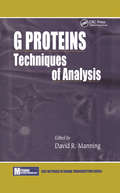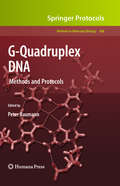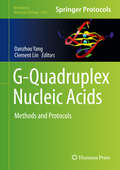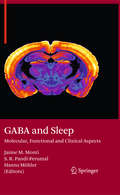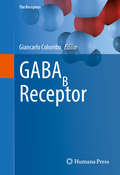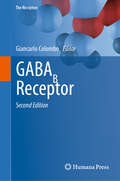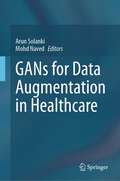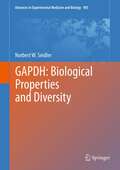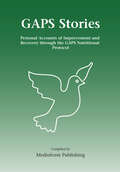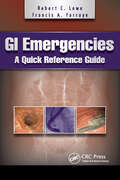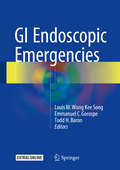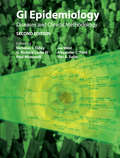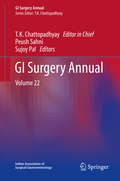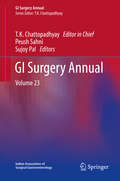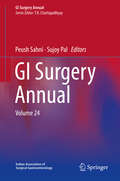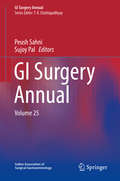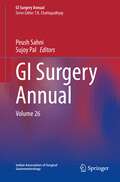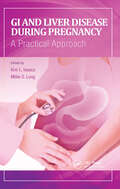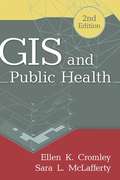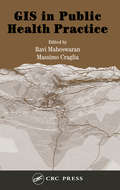- Table View
- List View
G ProteinsTechniques of Analysis (Methods in Signal Transduction Series)
by David R. ManningIncorporating a bench-top format, G Proteins: Techniques of Analysis covers essential methods - with a commitment to those techniques of proven and current utility. It offers an in-depth description of protocols, together with theory and representative data. It includes expression and functional analysis of G proteins; evaluation of covalent modifications and other regulatory phenomena; and, mapping pathways established among receptors, G proteins, and effectors. Incorporating contributors from key institutions, each contributor offers clear instructions to establish a synthesized, concise and consistent approach to each chapter, which is beneficial to both students and professionals.
G-Quadruplex DNA
by Peter BaumannRecent work has revealed that stabilizing G-quadruplexes in telomeric DNA inhibits telomerase activity, providing impetus for the development of G-quartet-interacting drugs, while G-quartet-containing oligonucleotides have been recognized as a potent class of aptamers effective against STAT3 and other transcription factors implicated in oncogenesis, proving these guanine-quartets to be a vital and rich area for future study. In "G-Quadruplex DNA: Methods and Protocols", experts in the field present a collection of detailed techniques for studying G-quartet formation, dynamics, and molecular recognition. Written in the highly successful Methods in Molecular BiologyTM series format, chapters include brief introductions to their respective topics, lists of the necessary materials and reagents, step-by-step, readily reproducible laboratory protocols, and notes on troubleshooting and avoiding known pitfalls. Authoritative and cutting-edge, "G-Quadruplex DNA: Methods and Protocols "promises to be a useful resource for those familiar with G-quartets as well as an easy entry point for those researchers from diverse fields who are just developing an interest in the exciting implications of G-quadruplex DNA.
G-Quadruplex Nucleic Acids: Methods and Protocols (Methods in Molecular Biology #2035)
by Danzhou Yang Clement LinThis volume covers the structures, properties, and functions of G-quadruplexes in a wide range of biological disciplines, including therapeutic intervention and biomaterial application. The chapters in this book explore a wide range of vital and new experimental techniques used in the study of G-quadruplexes. Written in the highly successful Methods in Molecular Biology series format, chapters include introductions to their respective topics, lists of the necessary materials and reagents, step-by-step, readily reproducible laboratory protocols, and tips on troubleshooting and avoiding known pitfalls. Practical and cutting-edge, G-Quadruplex DNA: Methods and Protocols is a valuable resource for both novice and experienced researchers who work in biophysics, structural biology, computational biology, biochemistry, and molecular and cell biology, and who want to learn more about the potential roles and effects of G-quadruplex in these fields.
GABA and Sleep
by Jaime M. Monti Hanns Möhler Seithikurippu Ratnas Pandi-PerumalGABA (gamma-aminobutyric acid) is the main neurotransmitter regulating sleep. The majority of drugs presently in use for the treatment of sleep disorders act by enhancing GABAergic neuronal inhibition. The GABA system is, therefore, of prime clinical relevance for the therapy of insomnia. The focus of this volume is on the neuropsychopharmacology and the clinical impact of the GABA system in regulating sleep and wakefulness. It presents molecular, neuropharmacological, systems-biological and clinical approaches to the understanding of the mechanism of action of GABA and GABAergic drugs. It also explores the role of GABA in the basic drives that affect sleep, and the influences that adapt sleep and wakefulness to external events.
GABAB Receptor
by Giancarlo ColomboAn up-to-date comprehensive overview of the GABA B receptor system with a particular focus on the most recent therapeutic applications and potential. This receptor system has recently been implicated in several diseases and disorders including gastroesophageal reflux disease, epilepsy, mood disorders, depression, and alcohol and substance use disorder. The authors, leading researchers in the field, explore a number of approaches, including medicinal chemistry, molecular biology, physiology, and preclinical and clinical pharmacology. This overview provides a translational perspective on the potential of the GABA B receptor pharmacology.
GABAB Receptor (The Receptors)
by Giancarlo ColomboThis new edition presents an up-to-date, comprehensive overview of the GABAB receptor system, including a particular focus on the most recent therapeutic applications and potential. This receptor system has been implicated in several diseases and disorders, including gastroesophageal reflux disease, epilepsy, mood disorders, depression, and alcohol and substance use disorder. The authors, leading researchers in the field, explore a number of approaches, including medicinal chemistry, molecular biology, physiology, and preclinical and clinical pharmacology. The new edition is completely reworked and updated, featuring the latest pharmacological advances on baclofen and positive allosteric modulators.
GAIN Positive and Mindful Self-Leadership: Toward Purpose Driven Insights
by Joan MarquesThis book proposes a new model, GAIN (Generating, Appreciating, Internalizing, and Newness) that shifts negative thinking patterns many find themselves in today’s society. Whether from extremely short-termed, thus unrealistic, expectations or general victim thinking, many people, particularly professionals, consider past experiences that don’t lead to immediate and tangible benefits as a waste of time. They forego long-span self-reflection to acknowledge their progress in life. This book uses mindful practices to shift these negative thought patterns into constructive ones that reveal personal purpose and growth, and thus, positive self-leadership and development. Featuring practices and exercises to support the GAIN model, this book will help readers see every life experience as a gain rather than loss, even if it may take some time to see the benefits from it, if at all.
GANs for Data Augmentation in Healthcare
by Arun Solanki Mohd NavedComputer-Assisted Diagnostics (CAD) using Convolutional Neural Network (CNN) model has become an important technology in the medical industry, improving the accuracy of diagnostics. However, the lack Magnetic Resonance Imaging (MRI) data leads to the failure of the depth study algorithm. Medical records often different because of the cost of obtaining information and the time-consuming information. In general, clinical data are unreliable, the training of neural network methods to distribute disease across classes does not yield the desired results. Data augmentation is often done by training data to solve problems caused by augmentation tasks such as scaling, cropping, flipping, padding, rotation, translation, affine transformation, and color augmentation techniques such as brightness, contrast, saturation, and hue.Data Augmentation and Segmentation imaging using GAN can be used to provide clear images of brain, liver, chest, abdomen, and liver on MRI. In addition, GAN shows strong promise in the field of clinical image synthesis. In many cases, clinical evaluation is limited by a lack of data and/or the cost of actual information. GAN can overcome these problems by enabling scientists and clinicians to work on beautiful and realistic images. This can improve diagnosis, prognosis, and disease. Finally, GAN highlights the potential for location of patient information with data. This is a beneficial clinical application of GAN because it can effectively protect patient confidentiality. This book covers the application of GANs on medical imaging augmentation and segmentation.
GAPDH: Biological Properties and Diversity
by Norbert W. SeidlerThe book represents a comprehensive review and synthesis of the biomedical literature that spans over a half-century on a single protein called glyceraldehyde 3-phosphate dehydrogenase (or, GAPDH). Due to the protein's involvement in a vast array of cellular activities, GAPDH is of interest to the cell biologist, immunologist, virologist, biochemist etc. The protein has a significant role in fertility, cancer and neurodegeneration, suggesting that this book can be a vital resource for drug development. GAPDH function may provide insight into anesthesia. Furthermore, GAPDH is highly conserved meaning that the protein found in microorganisms, such as pathogens, remained relatively unchanged in evolution. Pathogens use GAPDH as a virulence factor, offering a unique challenge in developing anti-microbial agents that target this protein. To the evolutionary biologist, a book on the multi-functionality of GAPDH provides a focal point for a cogent discussion on the very origin of life.
GAPS Stories: Personal Accounts of Improvement and Recovery Through the GAPS Nutritional Protocol
by Chelsea Green PublishingDr. Natasha Campbell-McBride created the term GAPS (Gut and Psychology Syndrome or Gut and Physiology Syndrome) in 2004 to describe the plethora of health problems that stem from an unhealthy gut. Since developing the GAPS nutritional protocol, Dr. McBride has received letters from GAPS sufferers all over the world: stories written by real people who have overcome their real health problems. Every one of these people has learned valuable lessons on their healing journey: lessons they are keen to pass to others who may be struggling through the same difficulties. These stories can be utilized as case studies for how to progress through personal healing and how to deal with problems that one may have to face along the way. There is nothing more valuable than real life experience! Those who have lived through something, fought the battle and won, know what is true and what is false, what works and what doesn&’t. Many of these stories are humbling–the kinds of horrific problems that people have had to deal with are hard to imagine for the majority of us–yet told with humor and grace!
GDPR Requirements for Biobanking Activities Across Europe
by Sabrina Brizioli Alessandra LangellaThe book deals with the effective operation of the rules related to biomedical research and pays attention to the activities of the national legislatures of the 27 Member States in the field of scientific research. This multilevel system has an impact on biobanking activity. The book answers questions realized by operators on the main biobanks around the EU in the field of GDPR. The authors and editors used the questions born from brainstorming among members of the Association European, Middle East & Africa for Biopreservation and Biobanking (ESBB) to offer to the operators in biobanking activity and researchers quickly answer to their daily questions, but with authors highest quality. Further the book provides a comprehensive review of the rapidly expanding field of biobanking. It provides researchers and scholars working on biobanking and bio-sharing and more in general in the university hospitals and clinical trial consortiums, and companies, biomedical researchers, but also jurists and the professionals (in particular judges, lawyers, officers) an instrument rigorous but easy to use of the GDPR in the case of biobanking activities. The book identifies a methodological path to tackle the legal or ethical problem on a specific scientific-technological to verify existing solutions and give ideas for future applications. The importance of the legal solution influences the implementation of the development of the biobanking activity service itself.
GDPR and Biobanking: Individual Rights, Public Interest and Research Regulation across Europe (Law, Governance and Technology Series #43)
by Santa Slokenberga Olga Tzortzatou Jane ReichelThis open access book focuses on the discrepancies in biobank research regulations that are among the most significant hurdles to effective research collaboration. The General Data Protection Regulation (GDPR) has established stringent requirements for the processing of health and genetic data, while simultaneously allowing considerable multi-level exceptions for the purposes of scientific research. In addition to directly applicable exceptions, the GDPR places the regulatory responsibility for further defining how the Member States strike a balance between the individuals' rights and the public interest in research within their national legal orders. Since Member States' approaches to the trade-off between data subjects' rights on the one hand, and appropriate safeguards on the other, differ according to their ethical and legal traditions, their data protection requirements for research also differ considerably. This study takes a comprehensive approach to determine how the GDPR affects regulatory regimes on the use of personal data in biobanking research, with a particular focus on the balance between individuals' rights, public interest and scientific research. In this regard, it has two main goals: first, to scrutinize the GDPR research regime, its objective and constitutive elements, the impact it has on biobanking, and its role in a changing EU landscape post-Brexit; and second, to examine how various exceptions have been operationalized nationally, and what challenges and opportunities this diversification entails. The book not only captures the complexity GDPR creates for biobanking, but also sheds light on various approaches to tackling the corresponding challenges. It offers the first comprehensive analysis of GDPR for biobanking, and the most up-to-date overview of the national biobank regulatory frameworks in Europe.
GENOME-BASED DIAGNOSTICS Clarifying Pathways to Clinical Use
by Steve Olson Adam C. Berger RapporteursThe sequencing of the human genome and the identification of associations between specific genetic variants and diseases have led to an explosion of genomic-based diagnostic tests. These tests have the potential to direct therapeutic interventions, predict risk or onset of disease, or detect residual disease. As research progresses and an increasing number of associations are found, further tests will be developed that can aid in providing personalized treatment options for patients. However, the adoption of genomic diagnostic tests by health care providers has been limited due to a lack of evidence regarding the clinical utility of many tests. Health funders and practitioners lack the data necessary to distinguish which tests can improve practice or the clinical settings in which tests will provide the greatest value. The Roundtable on Translating Genomic-Based Research for Health held a workshop in November 2010 to determine what evidence is needed and how it is viewed by different stakeholders in order to develop genomic diagnostic tests of clinical value. Genome-Based Diagnostics summarizes the presentations and discussions that took place throughout the workshop. Two presentations, in particular, sparked extensive discussion. One presentation proposed that all genomic diagnostic tests be reviewed and approved by the Food and Drug Administration. The other observed that venture capitalists are no longer investing substantially in the development of genomic diagnostic tests because of a lack of clarity surrounding regulatory and reimbursement pathways. Both presentations suggested the need for major changes in the systems used to develop, regulate, and reimburse genomic diagnostic tests. The report also presents the perspectives of different stakeholders in the development of genomic diagnostic tests. Each stakeholder group has a different set of needs and issues of importance, yet commonalities among them are apparent, such as the need to put patients and health outcomes at the center of discussion and action.
GGZ in de wijk: Participatief samenwerken in het sociaal en verpleegkundig domein
by Jasmijn De Lange Rosalie Metze Koen WestenDit boek helpt bij de ontwikkeling van goede integrale zorg in de wijk voor mensen met psychische aandoeningen. Het beantwoordt de vraag wat goed hulpverlenerschap in de huidige ggz betekent. Daarbij richt het zich in de eerste plaats op (aankomende) sociale en verpleegkundige professionals. Ook is het waardevol voor iedere professional die betrokken is bij mensen met psychische problematiek in de wijk, en die de integrale dienstverlening in het netwerk wil verbeteren. GGZ in de Wijk bevat veel praktische informatie, en voorziet de moderne netwerkprofessional van nieuwe kennis, nieuwe vaardigheden en innovatieve inzichten. Het boek is opgebouwd uit drie delen: kijk op de wijk, praktijk in de wijk, en dilemma’s in de wijk. Het eerste deel schetst het landschap en de ontwikkelingen. Het tweede gaat in op interdisciplinair samenwerken en sociale interventies. Het derde biedt een reflectie op het werken in de wijk. De inhoud en opbouw van het boek passen goed bij de beweging naar een leven lang leren. Het is geschikt voor verschillende opleidingsjaren, opleidingen en niveaus, en praktisch toepasbaar in de dagelijkse (stage)praktijk. Jasmijn de Lange is verpleegkundige, zorgethicus en onderzoeker in het Lectoraat Ggz & Samenleving, en werkt als docent voor deeltijdonderwijs ethiek, verpleegkunde en social work bij Hogeschool Windesheim. Rosalie Metze is sociaal werker en sociologe, en werkt voor Hogeschool Windesheim als associate-lector in het Lectoraat Ggz & Samenleving. Koen Westen is verpleegkundige met een master in social work en onderzoeker in het lectoraat Zorg rondom het Levenseinde. Daarnaast is hij docent Verpleegkunde bij Avans Hogeschool, vicevoorzitter van het CCAF en senior-onderzoeker van de onderzoekslijn herstelondersteunende netwerkzorg in de ggz voor ggz-organisatie Reinier van Arkel.
GI Emergencies: A Quick Reference Guide
by Robert Lowe Francis A. FarrayeGI Emergencies: A Quick Reference Guide contains practical information regarding the diagnosis and management of common gastrointestinal emergencies. Each chapter is written by a fellow or resident with an experienced clinician. This offers the perspective of a trainee, who has many basic questions about how to handle a given situation, combined with the experience of a seasoned practitioner who can guide the work-up and treatment of each clinical case. The result is a reference that provides the clinical acumen of a trained gastroenterologist in an easy-to-use format for physicians to approach GI emergencies efficiently and thoroughly. The dual-perspectives blend perfectly together to create a practical, evidence-based read for the learning physician.In GI Emergencies: A Quick Reference Guide, Dr. Robert C. Lowe and Dr. Francis A. Farraye, along with 20 contributors, help physicians deal with problems as they occur in a “real-time” format. Some Topics Include: • Evaluation and management of acute liver failure• Caustic ingestions, foreign bodies, and food impaction• Nonvariceal upper GI hemorrhage• Acute pancreatitis• Complications of endoscopyThe case-based format is less formal than that of a typical textbook, making it enjoyable without losing the educational value and evidence-based recommendations needed to provide excellent patient care. With succinct key teaching points, GI Emergencies: A Quick Reference Guide assists physicians who are training interns, residents, and medical students in training, making it an all-around reference for those in the gastroenterology field.
GI Endoscopic Emergencies
by Louis M. Wong Kee Song Emmanuel C. Gorospe Todd H. BaronThis volume provides a concise, yet comprehensive, state-of-the art overview of GI endoscopic emergencies. Although the emphasis is on endoscopic management, peri-procedural considerations, adjunctive medical therapy, and clinical approaches to commonly encountered GI emergencies are discussed in detail. This sets the stage for the in-depth review of current as well as innovative devices and techniques for endotherapy in GI emergencies. Technical aspects of endoscopic procedures are emphasized and supplemented by online video clips to enhance the educational experience. Written by experts in the field, GI Endoscopic Emergencies serves as a valuable resource for practitioners who deal with GI emergencies.
GI Epidemiology
by G. Richard Locke Yuri A. Saito Nicholas J. Talley Joseph J. West Paul Moayyedi Alexander C. FordThe only book to combine epidemiological analysis of gastrointestinal diseases with an examination of the methodologies of clinical research, GI Epidemiology, 2nd Edition, unites global experts to identify why and how GI diseases occur, to whom, and what can be done to prevent them. With new editors, new contributors, and a new, more user-friendly approach to epidemiology, this edition presents vital information in an accessible framework.
GI Surgery Annual
by Peush Sahni Sujoy PalThe twenty-second volume of GI Surgery Annual covers a gamut of topics from oesophageal adenocarcinoma, to motility disorders of the colon and rectum, mesenteric tumours as well as the contemporary technique of ALPPS, acute portal vein thrombosis and small for size syndrome in live donor liver transplant. The chapter on advances in gastrointestinal surgery as every year reviews the important new information in the field in an easy to understand manner.
GI Surgery Annual
by Peush Sahni Sujoy PalThe 23rd volume of this highly successful series includes new contemporary topics such as PET in HPB diseases, short gut syndrome, current status of extended lymphadenectomy in esophageal cancer, splenectomy for haematological disorders, postoperative liver failure, HIPEC, and current issues in surgery of pancreatic cancer. Finally, the chapter on advances in GI surgery, like in each volume in the past, reviews the important new developments in the field. The GI Surgery Annual 23rd Volume provides an overall round up of selected topics that are considered relevant and contemporary by the editors of the series.
GI Surgery Annual: Volume 23 (GI Surgery Annual #23)
by Peush Sahni Sujoy PalThe 24th volume of this highly successful series includes new contemporary topics such as corrosive injuries of the oesophagus, post-gastrectomy complications, advances in imaging of inflammatory bowel disease, unusual presentations of gallstones, gall bladder cancer with jaundice, minimally invasive pancreatic surgery, and enhanced recovery after surgery. Finally, the chapter on advances in GI surgery, like in each past volume, reviews important new developments in the field. The GI Surgery Annual 24th Volume provides an overall roundup of selected topics that were deemed particularly relevant and topical by the series editors.
GI Surgery Annual: Volume 25 (GI Surgery Annual #25)
by Peush Sahni Sujoy Pal T. K. ChattopadhyayThe 25th volume of this highly successful series covers a range of interesting topics, including biological therapy in inflammatory bowel disease, recent surgical approaches in rectal cancer, tumor markers in HPB and GI malignancies, bridging therapy for hepatocellular carcinoma, adjuncts to liver resection, IgG-related HPB diseases, ERCP-induced perforations and superior mesenteric artery syndrome. As in the previous volumes, the chapter on advances in GI surgery reviews the important new developments in the field. The GI Surgery Annual 25th Volume provides up-to-date information on current hot topics.
GI Surgery Annual: Volume 26 (GI Surgery Annual #26)
by T. K. ChattopadhyayThe twenty-sixth volume of GI Surgery Annual includes chapters on current and upcoming topics in gastrointestinal surgery pertaining to cholangiopancreatoscopy, robotic liver resections and transplants, primary familial intrahepatic cholestasis, managing a patient after total pancreatectomy, transplant immunology and immunosuppression as well as the chapter on advances in gastrointestinal surgery. The authors have expertise and excellent academic track record in the relevant subspecialties. Marrying academic excellence with publishing expertise is going to be the new mantra for the present as well as the upcoming issues of GI Surgery Annual.
GI and Liver Disease During Pregnancy: A Practical Approach
by Kim Isaacs Millie LongGI and Liver Disease During Pregnancy: A Practical Approach by Drs. Kim Isaacs and Millie D. Long is a unique handbook focusing on common gastrointestinal symptoms and diseases seen in pregnant patients. Each chapter addresses the diseases or symptoms and focuses on key questions to ask the patient and key points regarding diagnosis and management. This handbook is organized to have each chapter focus on a common complaint or discrete disease, making it easy to find exact information in a ready reference. Also provided are tables of drug safety during pregnancy and breast feeding. Unique features also include a section on alternative therapies and a chapter on care in post bariatric surgery patients.Each Chapter Covers:· Epidemiology· Pathology· Presentation and Evaluation· Management · Summary· Key PointsPocket-sized and easy to read, GI and Liver Disease During Pregnancy: A Practical Approach is a convenient and accessible reference for gastroenterology fellows, OB/GYN fellows and residents, and practicing gastroenterologists.
GIS And Public Health
by Sara McLafferty Ellen CromleyAuthoritative and comprehensive, this is the leading text and professional resource on using geographic information systems (GIS) to analyze and address public health problems. Basic GIS concepts and tools are explained, including ways to access and manage spatial databases. The book presents state-of-the-art methods for mapping and analyzing data on population, health events, risk factors, and health services, and for incorporating geographical knowledge into planning and policy. Numerous maps, diagrams, and real-world applications are featured. The companion Web page provides lab exercises with data that can be downloaded for individual or course use.
GIS in Public Health Practice
by Massimo Craglia Ravi MaheswaranSignificant advances in the evaluation and use of geographic information have had a major effect on key elements of public health. Strides in mapping technology as well as the availability and accuracy of health information enable public health practitioners to link and analyze data in new ways at international, regional, and even street levels. Th
